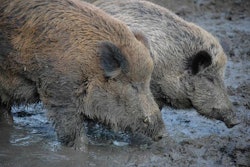
As the scale of devastation to the pork sectors of China caused by African swine fever (ASF) becomes evident, it is clear that the global production and trade in pork, other meats and livestock feed ingredients will all be significantly affected.
Since ASF first broke out in China in August 2018, the disease has spread to all parts of the country. The last province to confirm pig mortality and the detection of the virus is Hainan, an island in the South China Sea.
The agriculture ministry puts the number of outbreaks at 129, and the loss of animals at 1.02 million from culling, reported South China Morning Post recently. Official sources in China put the number of sows in March 2019 at 375 million, a fall of 21 percent on 12 months previously.
Although just a couple of weeks ago, high-level officials were insisting that the ASF situation in China was under control, the scale of the losses may be higher, and the possible impacts even greater.
ASF is likely to lead to the elimination of 30 percent of China’s domestic hog poulation according to Christine McCracken, a senior protein analyst for proteins covering North America. She was speaking at a recent International Poultry Council conference in New Orleans.
Because pork breeding operations in China have been devastated by the disease, she said, even if there were to be no further outbreaks, it could take eight years to return the country’s breeding capacity to pre-ASF levels.
Pork industry leaders in the U.S. said they are skeptical that Chinese authorities have the ASF under control as they claim.
Future impacts on the global pork market
Before ASF struck, China was the world’s top pork producer with an annual output of 54 million metric tons (mmt), according to Justin Sherrard, global strategist for animal protein with Rabobank Food and Agribusiness.
If ASF cuts China’s pork production by as much as 30 percent, the world simply won’t be able to fill that gap quickly, he said in a recent podcast. If they were to prioritize China over other export markets, the leading pork-producing countries could raise output by 1.5-2 mmt, estimates Sherrard.
Pork from the global No. 2 producer, the U.S., is subject to a 50 percent tariff on top of the 12 percent paid by other exporters into China, effectively creating a barrier to the trade. If this barrier can be overcome, the U.S. is best placed to fill the pork supply gap in China.
Without diverting pork from other export markets or using up reserves, the European Union has little capacity to increase its exports to China as this is already the region’s top market for this meat, according to Sherrard.
He added that the pork shortage in China is exacerbated by the spread of ASF to other Southeast Asian nations, including Vietnam, Cambodia and likely also Laos and Myanmar.
World protein markets affected
In China, the pork supply situation has led to the substitution with other animal proteins, according to Rabobank senior analyst, Angus Gidley-Baird, particularly chicken, but also seafood, beef and sheep meat.
Already in the first quarter of 2019, imports of beef and sheep meat from Australia to China are significantly higher than last year, according to Sherrard, but this may not continue, he said. The “gray trade” in carabeef (from buffalo) from India to China via Vietnam has been disrupted by increased land border checks set up to control ASF. This has led to a sharp drop in the price of carabeef, and India will be looking for alternative markets for this product.
ASF in China and elsewhere in Asia looks likely to impact global trade in all animal proteins this year, next year, and the years ahead, according to Sherrard, and China will have to set up new international trade partnerships to maintain food security.
Last year, Rabobank forecast an increase in global pork output of 1 mmt in 2019, but this has been revised in the light of ASF in China to a fall of 13 mmt, said Gidley-Baird.
The responses in pork production in other parts of the world are hard to quantify, he said. There are likely to be changes both temporary and permanent, and both opportunistic and structural, based on the development of long-term partnerships.
Brazil’s agriculture minister has forecast that her country’s pork exports to China will help to fill the supply gap resulting from the decline in domestic production, reported Asia Times this week.
Brazil is the world’s top soybean exporter, and China is the world’s leading importer, according to Minister Tereza Cristina Dias. She said Brazil’s future increased trade in pork with China would help to compensate for the loss of soybean export volume.
A recent sharp fall in soybean futures traded in Chicago has been attributed to forecasts of reduced future demand for feed by the Chinese pork sector, reported Xinhua.
View our continuing coverage of the African swine fever outbreak.

















